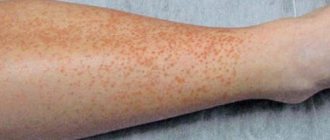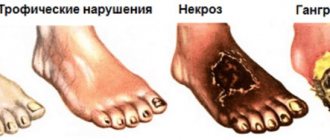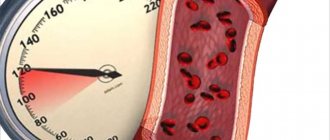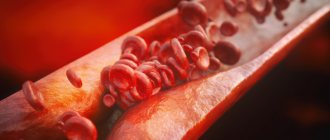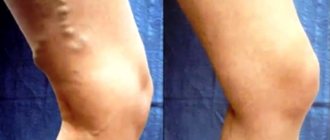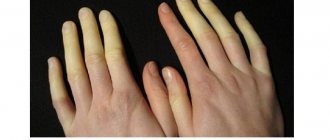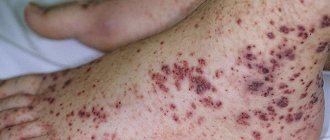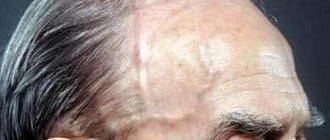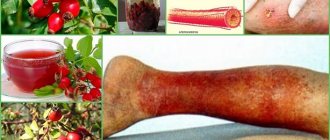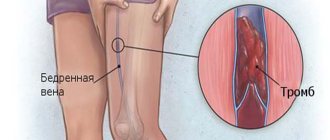Causes
The disease is caused by the following reasons :
- Allergic reactions provoked by infectious pathologies.
- Chronic illnesses.
- Side effects of medications.
- Complications after arthritis.
- Thyroiditis.
- Autoimmune pathologies.
- Stress.
- Congenital anomalies.
What does the disease look like?
Vasculitis with damage to the skin of the legs is a consequence of complications from the following diseases:
- Caused by streptococci - tonsillitis, sinusitis, scarlet fever.
- Consequences of mycoplasmosis, salmonellosis, tuberculosis.
- Manifestations of sexually transmitted infections.
What is prohibited to eat
In order not to provoke an allergic reaction of the body, cocoa and products containing it, citrus fruits and most tropical fruits are completely excluded from the diet (bananas can be eaten in small quantities after testing for allergenicity). Highly allergenic products include honey and baked goods containing it, as well as any nuts. It is not recommended to include mushrooms in your diet.
Important information: Systemic vasculitis: treatment, symptoms, classification
Allergenic foods such as any canned food (they contain added preservatives, sweeteners, vinegar, etc.), smoked sausages, meat and fish delicacies, and seafood should be strictly prohibited. When purchasing baked goods, you should not choose those that contain vanilla and vanillin, margarine, poppy seeds and food coloring. Prohibited foods include corn and wheat cereals, semolina and millet.
Pork and chicken are included in the diet with caution: these types of meat are grown using antibiotics and hormonal substances. The meat should be thoroughly boiled, draining the first boiling water.
Forms of vasculitis
There is an initial form of vasculitis, which is an independent disease, and a secondary form, provoked by another disease. The following types of pathology are distinguished:
- Purpura. Inflammation of capillaries of allergic etiology. The kidneys and joints are affected.
- Cryoglobulinemic angiitis. The renal glomeruli are damaged, as well as the vessels of the skin of the legs.
- Leukocytoclastic vasculitis. The disease is limited to the blood ducts of the lower extremities.
- Microscopic polyangiitis. It is characterized by the death of small and medium-sized vessels.
- Erythema nodosum. It is characterized by damage to the blood ducts of the subcutaneous tissue.
Treatment of the disease
The disease occurs mainly in the following variants:
- Hemorrhagic.
- Erythematous.
Hemorrhagic vasculitis is a superficial vasculitis characterized by the appearance of a rash. The pustules unite and bloody spots form on the legs. The skin swells greatly. The affected areas become necrotic, defects appear, which gradually heal, forming pigmented scars. , ulcerative necrotizing vasculitis develops .
Erythematous angiitis is the result of an allergic response to drug therapy in the treatment of chronic diseases. Purple nodules form on the lower leg, surrounded by swollen areas of skin. This is a deep form of the disease. When palpating the formations, severe pain is felt. After recovery, there are no spots on the affected areas.
Depending on the form of the disease, the doctor prescribes treatment, which must be started immediately.
Important! After suffering from superficial vasculitis, pigmented scars form in the affected areas.
In the deep form of the disease, no pigment spots remain on the skin.
Vasculitis - what kind of disease it is, causes and diagnosis
Vasculitis can be caused by severe hypothermia
Vasculitis is an autoimmune disease that affects the vessels of the circulatory system. During development, it can affect various organs. The likelihood of developing vasculitis directly depends on the state of the immune system. When taking preventive measures, the risk of infection is reduced.
Causes of secondary vasculitis: previous infections, hypothermia or overheating of the body, burns, allergic predisposition, stress.
The causes of primary vasculitis are unknown. It develops independently and can be triggered by a hereditary predisposition to the disease.
It is diagnosed visually by characteristic rashes on the skin. If vasculitis is suspected, a scan of the condition of the vessels is performed, and a skin biopsy is performed to determine the severity. The presence or absence of granulocytes in the analysis allows us to determine the subtype of the disease and develop a treatment method.
Symptoms
Vasculitis of the lower extremities is manifested by the following general symptoms:
- Anemic skin.
- Excessive fatigue, weakness.
- Symmetrical hemorrhagic spots .
- Itching in pigmented areas.
- Joint and muscle pain.
How to treat the disease
Symptoms of the disease are varied and can manifest themselves in the following types:
- Rashes in the form of plaques, blisters, nodules. Initially, superficial vasculitis occurs on the legs, then spreads to other parts of the body.
- The formation of purpura, which is red spots of different sizes, voluminous to the touch. The defects increase and merge. The tissues die, forming ulcerations. Purpura spreads to the oral mucosa.
- Pinkish nodules form. They are painless and resemble hazelnuts.
- Marble vasculitis is observed in girls during their growing years. Blue spots are formed that resemble a wriggling mesh. In the cold, the marbling of the skin becomes more noticeable.
- Senile hemosiderosis manifests itself as red brown spots and pinpoint hemorrhages. They peel and itch.
Sample menu
The diet for vasculitis can include:
- soups made with vegetable broth without seasoning;
- meat and fish of low-fat varieties, offal in boiled, steamed, stewed form (in case of gastrointestinal lesions, prepare dishes with preliminary grinding);
- buckwheat, oatmeal, barley and pearl barley porridge, brown rice;
- potatoes (boiled);
- grain or bran bread, biscuits, dryers and bagels, durum wheat pasta;
- fermented milk products without additives (kefir, fermented baked milk, yogurt), cottage cheese;
- chicken eggs in omelettes or boiled soft-boiled (introduce gradually to children if there is no allergy);
- melted butter (in small quantities);
- corn and olive oil;
- leafy vegetables, cabbage, zucchini and squash, green peas and green beans in stewed or boiled form, cucumbers and greens - fresh and only in their season (for intestinal syndrome - vegetables are only boiled in the form of puree);
- apples and pears, light cherries, white currants (for gastrointestinal lesions - baked apples);
- compotes, weak and green tea, still alkaline water.
Important information: How to treat cutaneous vasculitis and its symptoms
The menu during remission is based on table No. 5. An approximate version for several days might look like this:
- Buckwheat porridge, baked apple and tea with dried fruits for breakfast. The second meal after 2-3 hours consists of cottage cheese casserole and compote. For lunch - vegetable soup, meatballs with a side dish of rice, jelly. In the afternoon - kefir with biscuits. For dinner - potato cutlets with cucumber salad, compote.
- Breakfast of rice porridge and compote with biscuits. Second breakfast: meatballs, tea. For lunch, pureed zucchini soup, boiled beef, compote. In the afternoon - tea, a slice of bread with jam. For dinner - boiled noodles with cabbage cutlets, tea.
- For breakfast - oatmeal, herbal tea, unsweetened cookies. Steamed omelette and jelly - second breakfast. For lunch - soup with vegetables, steamed fish cutlets with mashed potatoes, compote. In the afternoon - cottage cheese with pear. Dinner - vegetable stew, meatballs, tea.
When creating a menu, it is advisable to select a recipe for a dish so that it does not require the inclusion of fried dressings. In vegetable soups, all ingredients are placed raw and brought to full readiness.
Diagnostics
If a patient finds pigment spots on his legs, he has a question: “ Which doctor treats vasculitis?” First of all, make an appointment with a therapist. He makes an initial diagnosis and refers the patient to a rheumatologist or dermatologist .
Treatment of the disease is prescribed by the doctor
The specialist prescribes the following studies:
- Urine analysis. In the superficial form of the disease, leukocytes, red blood cells, and protein will be found in it.
- Hematological tests. Angiitis will be indicated by a low hematocrit and hemoglobin with leukocytosis and a high platelet count.
- Construction of a coagulogram that evaluates blood clotting.
- Biopsy. Pathological material is collected from the affected area, upon examination of which a final diagnosis is made and appropriate treatment is prescribed.
Which doctor treats vasculitis on the legs?
In order to begin treatment of the disease in a timely manner and avoid negative consequences, you need to know which doctor to contact with this problem.
The treatment of the cutaneous form of vasculitis is carried out by a dermatologist; in other forms, additional consultation with other specialists may be required.
Is it possible to cure vasculitis forever?
Experts give a favorable prognosis for the pathology, provided that treatment began on time and the patient strictly followed all the doctor’s instructions.
Treatment
Treatment of the disease is developing in the following directions:
- Drug treatment.
- Diet therapy.
- Physiotherapy.
Disease examination
Drug treatment of angiitis is carried out in 3 stages:
- A short course of intensive aggressive therapy.
- Long-term use of drugs that suppress the immune system. The course of treatment can last about two years.
- Preventing relapses.
Intensive therapy for angiitis is carried out using the following groups of medications:
- Anti-inflammatory glucocorticosteroids. The antiphlogistic properties of Metipred (the active component methyl prednisolone) appear to be an inhibition of the process of release of the inflammation mediator from eosinophils. The immunosuppressive effect is manifested by the involution of lymphoid textures.
- Nonsteroidal antiphlogistants. Indomethacin relieves the inflammatory reaction, has an analgesic and antipyretic effect, and prevents platelet aggregation and thrombus formation.
- Angioprotectors - Anginin, Prodectin, Parmidin. Restore capillary microcirculation. Reduce the permeability of vascular walls and prevent the formation of blood clots. Dissolves atherogenic deposits deposited inside the blood ducts. They stop itching and lead to the disappearance of erythema. Ascorutin strengthens collagen fibers of vascular walls.
During the acute course of the disease, monitor accompanying symptoms.
If the heart, lungs, kidneys, or other organs are affected, antimicrobial agents and symptomatic drugs are used for treatment.
Your doctor may prescribe chemotherapy treatment to suppress an overactive immune system.
Taking immunosuppressants Cytotoxin, Cyclophosphamide for vasculitis prevents the development of cells of modified tissues, inhibits the development of autoimmune processes in rheumatoid arthritis and other collagenoses.
As prescribed by a rheumatologist, the treatment of this dangerous disease involves a combination of antidepressants, glucocorticosteroids, angioprotectors, antiplatelet agents and anticoagulants. Suprastin and other antihistamines are used to relieve allergic conditions.
Relapse Prevention
To treat vasculitis on the legs, antiseptics are used - Diamond Green, Ethacridine. For ulcerative necrotic angiitis, Iruksol ointment is used to treat and heal defects. If the skin lesions are superficial, Solcoseryl is used. When stabilization is achieved, drug therapy is suspended. People who have had a severe form of angiitis need lifelong medical supervision.
Important! Treatment uses potent drugs - immunosuppressants. The course of treatment can last for years.
Diet therapy
Drug treatment does not bring the desired result if the patient does not follow a strict diet. It consists of prohibiting the consumption of products containing high amounts of allergens and metabolites that irritate the skin or walls of blood vessels.
What not to eat if you are sick
A diet for vasculitis involves excluding the following ingredients from the diet:
- Citrus.
- Cocoa.
- Coffee.
- Strong tea.
Limit the consumption of animal protein, salty and canned foods, chocolate, and sweets. Food should be served warm, but not too hot. The daily diet is divided into 5…6 servings.
How to treat vasculitis on the legs with gymnastic exercises?
Techniques have been developed to stimulate the acceleration of blood flow in the affected limbs, aimed at relieving itching and eliminating muscle-joint pain. To prevent excessive blood flow to the affected legs, it is helpful to keep them elevated when lying down.
Product Options
Highly allergenic foods are those foods that cause allergies most often. These include:
- Seafood: fish and caviar, shrimp, lobster, oysters, squid.
- Whole milk products and chicken eggs.
- All kinds of smoked meats, marinades and canned goods.
- Various seasonings, nuts, mushrooms, hot and sweet peppers, sorrel, celery, pumpkin, tomatoes, eggplants, carrots and beets.
- Highly allergenic foods are all red and orange fruits (citrus fruits, melon, etc.).
- Sweets: sparkling water, sweetened yoghurts, chewing gum, honey, candy.
- Dried fruits: figs, dates, dried apricots, raisins.
- Drinks: coffee, tea, cocoa.
- “Overseas” products that do not grow in your area of residence. For the CIS these are avocados, mangoes, bananas and others.
- Any products containing food additives.
- Alcohol.
Moderately allergenic products include:
- Porridge: buckwheat, corn, wheat.
- Meat products: poultry, rabbit, lamb, pork, horse meat.
- Potatoes, green peppers.
- Legumes: lentils, beans, peas, nagut.
- Berries: lingonberries, currants, cranberries.
Low allergenic products:
- Natural lactic acid products that do not contain any additives: kefir, cottage cheese, etc. Butter, vegetable oils. For example, yoghurts, beloved by many, do not belong to this group (they are highly allergenic).
- Meat products: veal, lean pork, chicken. By-products: kidneys, tongue, liver, heart.
- Sea fish: cod, sea bass.
- Porridge: rice, pearl barley, oatmeal. Bread and crispbreads.
- Cabbage (any), zucchini, cucumbers, parsley.
- White and yellow cherries, pears, gooseberries, white currants, apples and pears (as well as dried fruits from them), rose hips.
- Weak tea and still water.
Special Moments
Allergic processes to one degree or another are present in any vasculitis, and not just in hemorrhagic one.
During an exacerbation of vasculitis and for some time after it, you need to eat exclusively hypoallergenic foods. This applies to both adults and children.
Including products from other groups is allowed only after consultation with your doctor. Even during remission, preference should be given to hypoallergenic foods, and the principles of proper nutrition should be followed throughout your life.
Be sure to exclude grapefruit and grapefruit juices as they neutralize medications!
An important point is the method of preparing dishes. During an exacerbation, fried foods, canned food, saltiness, and smoking should be excluded. Give preference to boiled, stewed and steamed dishes. There should be 4-5 meals a day, which will normalize the functioning of the gastrointestinal tract, which often suffers with vasculitis. You shouldn’t overeat, but you need to eat different foods from the list of allowed ones. It is not recommended to eat one product more than once every three days. You should limit your salt intake to reduce swelling.
Consequences
Why is vasculitis dangerous? Vascular pathologies are often accompanied by damage to the kidneys, lungs, liver, alimentary tract or are symptoms of these diseases. A drop in the rate of blood circulation in the tissues surrounding the damaged tissues causes the organs to lose their functions. Vasculitis, which manifests itself as rashes on the legs, can affect vessels of different sizes in any part of the body.
Problems if left untreated
If treatment is not started on time, the following diseases develop:
- Permanent renal failure.
- Peritonitis resulting from perforation of the duodenum or stomach.
- Intestinal obstruction.
- Internal hemorrhages.
- Myocardial infarction.
- Stroke.
Important! Vasculitis is dangerous because it can damage vessels of different sizes in any part of the body and cause chronic diseases of internal organs.
What happens if vasculitis is not treated?
Treatment of vasculitis is mandatory.
Lack of adequate therapy can lead to serious complications, such as:
- Kidney/liver failure;
- Intestinal obstruction;
- Multiple neuritis and neuralgia;
- Partial or complete destruction of certain intestinal areas, which leads to the penetration of intestinal contents into the abdominal cavity. The result can be various inflammatory processes, peritonitis, sepsis.
Prevention
A person suffering from vascular diseases needs to adapt to changed conditions and beware of exposure to harmful factors:
- Stressful situations.
- Hypothermia, as well as infection with infectious diseases.
- Self-medication.
- Alcohol abuse.
- Gluttony.
- Smoking.
- Prolonged exposure to cold water.
- Excessive rubbing of the shins when washing.
Only if all recommendations are followed will the treatment be effective.
Treatment regimens for various degrees of pathology severity
It is necessary to treat angiitis of varying severity according to different schemes. The first degree of severity of the disease is characterized by vascular damage and the appearance of superficial symptomatic pigment spots. The skin is affected to a limited extent by small rashes, in which the temperature does not rise, and there is no muscle or joint pain. A blood test in the first degree of damage gives normal values, with the exception of the erythrocyte sedimentation rate, which is increased.
For patients suffering from this type of disease, non-steroidal anti-inflammatory drugs are indicated, among which are Nimesulide, Indomethacin, Meloxicam. Antibacterial drugs for the treatment of the disease are Doxycycline, Ciprofloxacin, Azithromycin.
To destroy microbes, quinolines are indicated - Chloroquine, Hydroxychloroquine, and Desloratadine, Levocetirizine, Fexofenadine are indicated as antihistamines.
In the second degree of severity of the pathology, the patient’s condition is characterized by a significant deterioration. The skin is no longer affected locally, but everywhere. The body temperature exceeds low-grade fever, and the blood test shows that most indicators exceed the acceptable limits. Patients suffer from weakness, muscle and joint pain, and neuropathy. At this degree of the disease, the treatment regimen is more complex; a larger number of drugs from different groups are prescribed.
Patients are prescribed systemic glucocorticoids - Betamethasone, Prednisolone, and to reduce the harmful effects of these drugs on the body, proton pump inhibitors are used, among which Omeprazole is important. As with mild cases, patients should take Nimesulide, Doxycycline or Meloxicam. Antibacterial drugs for patients with severe vasculitis are Azithromycin, Ofloxacin and Amoxicillin.
Antibiotics are essential drugs in the treatment of vasculitis
The drugs Pentoxifylline, Anavenol, Diosmin, Hesperidin are indicated as angioprotectors. Among antihistamines, doctors recommend Cetirizine, Ebastine, Levocetirizine. To remove toxins, the drug Dextran is used.
